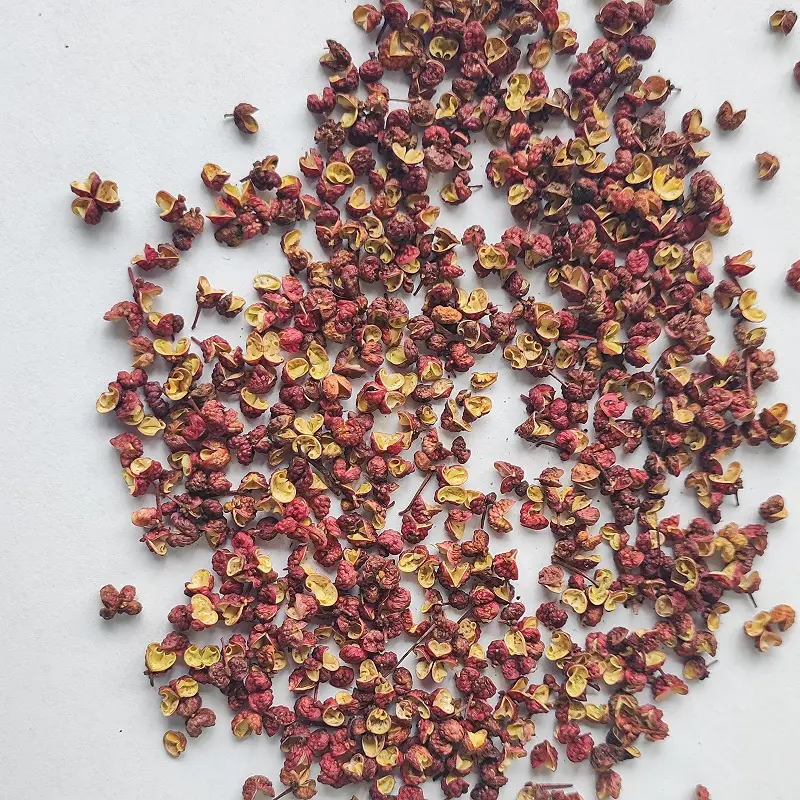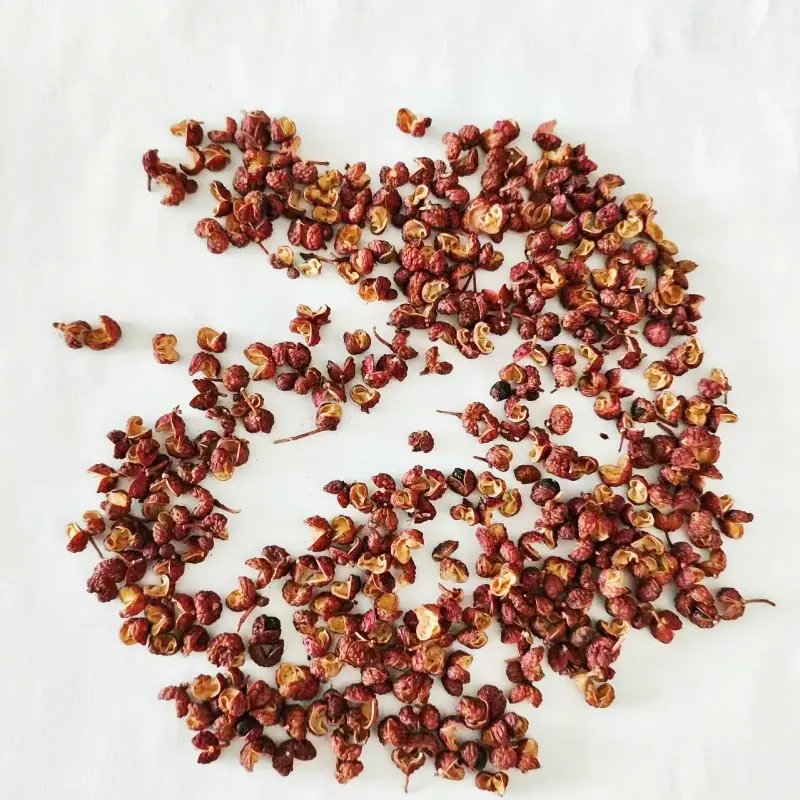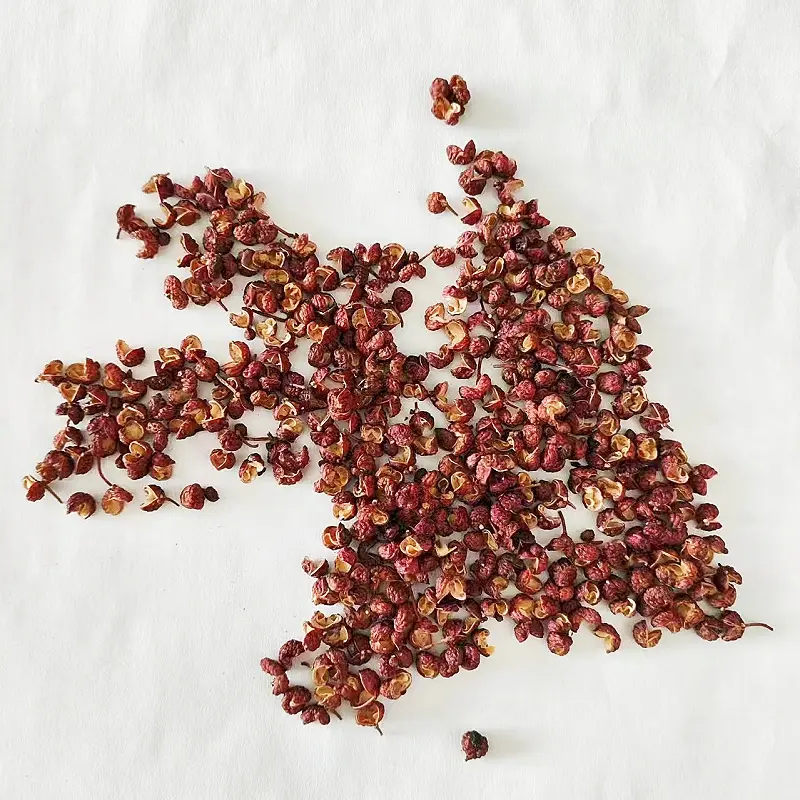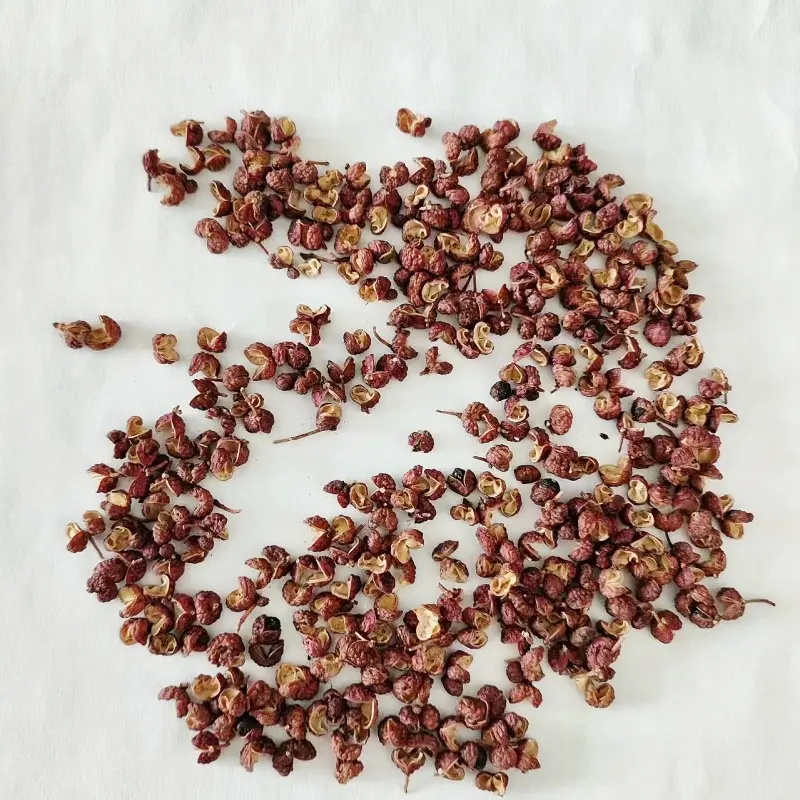Chinese cuisine is world-renowned for its diverse flavors, aromatic spices, and harmonious combinations of ingredients. Among the many condiments, one stands out for its unique taste and aroma - the Chinese peppercorn. In this article, we'll take a deep dive into the varieties of Chinese peppercorns, the regions in China where they're grown, and explore their history, culinary uses, and cultural significance.
What is Chinese peppercorns?
Chinese peppercorns (Zanthoxylum bungeanum Maxim), also known as hua jiao(花椒), Sichuan pepper, is a perennial deciduous small tree of the Rutaceae family and the Zanthoxylum genus. It ranks first among the "thirteen spices" of condiments and is known as the "king of seasoning". It has a tall stem, short thorns on the branches, and small leaves that are opposite and sessile. The inflorescence is terminal or terminal on the side branches; the tepals are yellow-green, and are roughly the same in shape and size; female flowers rarely have developed stamens. The fruit is purple-red, with a single schizocarp with slightly raised oil spots. It blooms in April and May and bears fruit in August, September or October. Because the peel has small protruding oil spots that are spotted and resemble flowers, it is called "peppercorn".
Zanthoxylum bungeanum is a widespread species. It is native to China and native to the Himalayas. It is now distributed in Japan, South Korea and other countries. It is distributed in all provinces and regions of China except Taiwan, Hainan and Guangdong. There are two ways to reproduce Zanthoxylum bungeanum. Sexual reproduction is completed by seed sowing, and vegetative reproduction is completed by root and stem grafting, cuttings, etc. Sichuan pepper is mostly found in plains to high-altitude mountains. It is drought-resistant, likes sunshine, has strong ability to survive alone, and is planted in many places.
Sichuan pepper has been recorded in Chinese herbal books of all dynasties. It was first seen in the "Book of Songs" and was first used as medicine in the "Shennong Herbal Classic". Sichuan pepper is pungent, dispersing, warm and dry in nature. It enters the spleen and stomach and is good at warming the middle and drying dampness, dispersing cold and relieving pain, stopping vomiting and diarrhea. It is often used for symptoms such as cold pain in the abdomen, vomiting, diarrhea, and loss of appetite. In addition, Sichuan pepper can also drive roundworms and kill insects, and can be used for abdominal pain caused by worm accumulation in children. However, eating too much Sichuan pepper can cause poisoning. Sichuan pepper contains safrole, which has a certain toxicity. In mild cases, it can damage liver function. In severe cases, it can cause human poisoning and syncope. Sichuan pepper wood is a typical light yellow, the air is dark yellow, the wood structure is dense, uniform, and bright, and the wood has artistic value.
Culinary Uses
Chinese peppercorns are celebrated for their unique flavor profile, which is characterized by a citrusy tang and a numbing sensation known as "ma" or 麻 in Chinese cuisine. This distinctive numbing effect, caused by compounds such as hydroxy-alpha sanshool, is a hallmark of Sichuan cuisine and is believed to enhance the overall dining experience.
In Chinese culinary traditions, peppercorns are used whole or ground to infuse dishes with their unmistakable aroma and flavor. They are a key ingredient in famous Sichuan dishes such as mapo tofu, kung pao chicken, and hot pot. Additionally, Chinese peppercorns are often paired with chili peppers to create the iconic flavor profile of Sichuan cuisine – a perfect balance of heat, spice, and numbing sensation.
Beyond Sichuan cuisine, Chinese peppercorns are also utilized in various regional dishes across China, adding depth and complexity to stir-fries, soups, and marinades. Their versatility extends beyond savory dishes; they are sometimes incorporated into desserts and beverages for a surprising twist of flavor.
Types and production areas of Chinese peppercorns
Definition: Zanthoxylum bungeanum is a small deciduous tree of the family Rutaceae and Zanthoxylum bungeanum with a height of up to 7 meters; The spines on the stems, the branches have short spines, and the current year branches are pubescent.
Distribution: It is distributed from the south of Northeast China in the north, to the northern slope of Wuling in the south, to the coastal areas of Jiangsu and Zhejiang in the southeast, and to the southeast of Tibet in the southwest. It is not produced in Taiwan, Hainan and Guangdong. It is found in plains to higher altitude mountains, and in Qinghai, it is also cultivated on slopes at an altitude of 2,500 meters. Drought tolerant and sunny, planted in various places.
Species: red peppercorns, green peppercorns.
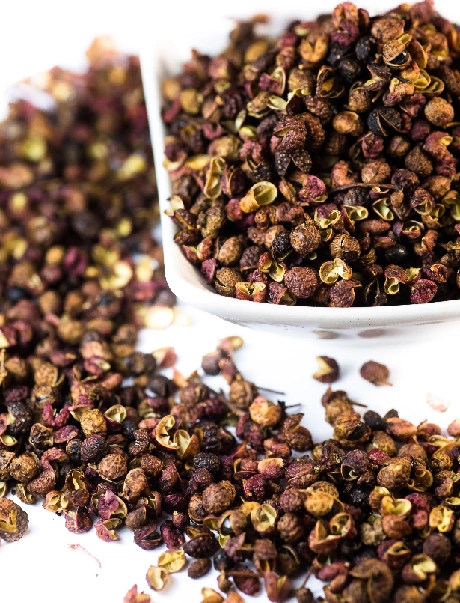
• Big Red Robe:
Mainstream red pepper (1) Gansu red pepper. (2) Sichuan red pepper, (3) Shaanxi Hancheng Dahongpao.
• Characteristics of various varieties of Da Hong Pao:
• (1) Gansu red pepper, large particles, bright red color, closed eyes pepper less (less than 6), the narrowest price range (high quality uniformity), the market price is also the highest, the market pepper oleoresin is basically made of this variety.
• (2) Maowen pepper and Gansu Wudu red pepper belong to the same variety of pepper, but the overall quality and price are better than Wudu red pepper, but the quantity is small, the market does not add adulteration (Maowen Dahongpao adulteration is mainly similar to the color of small particles of Wudu red pepper, part of the good color of Hancheng Dahongpao and Gansu cotton pepper) is very little, not enough to independently support a banner.
• (3) Cotton pepper is a pure mixed variety, which is not the same variety as Longnan Dahongpao, with small particles, light flavor and low price, which is generally not seen on the market.
• (4) Hancheng Da Hong Pao and Longnan Da Hong Pao is not the same variety, Hancheng Da Hong Pao is larger, but it is not accepted by the public in Sichuan, most of them are used as adulteration in previous years, and the number of people who accept Hancheng Da Hong Pao has gradually increased in the past one or two years, and the price is close to the mainstream of the three varieties of pepper.
Gansu red pepper:
Gansu red pepper: also known as Fu pepper, the color is red and heavy, the grain is large and full, the fragrance is rich, and it is a mellow flavor type
Hempin content is about: 40-45 (mg/g), many extracted ingredients, high essential oil content, and the extraction industry mostly uses Gansu pepper as the extraction raw material.
Production area: Wudu, Qin'an, Gangu, Tianshui;
Using Companies:
Weilong--Wudu production area: 700-800 tons/year
Lao Gan Ma - Wudu, Tianshui production area: 500-600 tons/year
Haidilao - Wudu, Tianshui production area: 600 tons/year
Juewei duck neck - Tianshui production area: 500 tons/year
Remark:
Wudu - the hometown of Chinese peppercorns. Wudu is one of the origins of Zanthoxylum pepper in China, with a history of cultivation of more than 2,000 years. At present, the planting area of Zanthoxylum bungeanum in the district is 904,000 mu, and the annual output of Zanthoxylum is 10.2 million kilograms, which can be called "the first county of Zanthoxylum in China". Wudu pepper is famous far and wide, selling well all over the country, and the pepper of the famous restaurant chain Little Sheep Hot Pot Restaurant all comes from Wudu, Gansu. Among them, the color and hemp taste of Wudu pepper are better, and Wudu is also known as the capital of pepper. China's first pepper museum opened in Wudu, the hometown of the famous pepper.
Wudu pepper has excellent quality, and the folk is called "Da Hong Pao", which is characterized by heavy color red oil, large and full grains, rich fragrance, mellow hemp flavor, many medicinal ingredients, and high essential oil content.
Wudu pepper quality characteristics:
(1) External sensory characteristics of Wudu pepper: Wudu pepper has a unique mellow hemp taste, and the aroma is strong, and there is no fishy smell and other peculiar smells. After drying, the exocarp is dark red, the endocarp is yellow, the peel is plum blossom-shaped after cracking, the peel is thick, the particles are uniform, and the average weight of 1000 grains of dried pepper is 18 grams. The overall sensory characteristics were characterized as "red color, heavy oil, large and full grains, mellow hemp taste, and rich aroma".
(2) The intrinsic quality characteristics of Wudu Zanthoxylum: the alcohol extract content of Wudu Zanthoxylum was higher than 17%; unsaturated fatty acids higher than 59%; The volatile oil content is higher than 3%.
Sichuan red pepper:
Sichuan red pepper: also known as southern pepper, the fruit is relatively small, the color is ruddy (red to purple), the oil capsule is full, and it is an orange flavor type
The content of hemp is about: 38-43 (mg/g), the oil is heavy, the fragrance is suitable for making pepper oil, extraction, and at the same time used in various marinated vegetable industries and hot pot bases;
Production area: Hanyuan, Yanyuan, Liangshan Prefecture, etc
Using Companies:
Li Hong, fresh on the tree, Ding Dianer, etc. all use fresh peppers.
Hancheng Big Red Robe:
Hancheng red pepper: Hui large grains, bright color, thick skin and rich meat, rich fragrance, belongs to the strong flavor type;
The content of hemp is about: 24-30 (mg/g), its explosive power is good, the volatile oil is moderate, but the hair style is good, suitable for matching with the sauce fragrance, the flavor is complete, because of its numbness lag, also known as: back pepper.
Production area: Shaanxi Hancheng, Heyang, Fuping
Application products: thirteen incense, Xuyi lobster feed, etc
Green peppercorns:
There are three main varieties of green peppercorns:
(1) Jinyang green pepper (2) Yunnan Zhaotong green pepper (3) Chongqing Jiangjin green pepper.
The small varieties are: (4) Yunnan Huaping green pepper.
Among the three mainstream peppercorns, green peppercorns have the most small origins, the quality of the goods is the most uneven, the price range is also the widest (the difference in quality uniformity is large), the closed-eye pepper (15-80, according to the processing technology), the market price is judged and negotiated according to the opening and color.
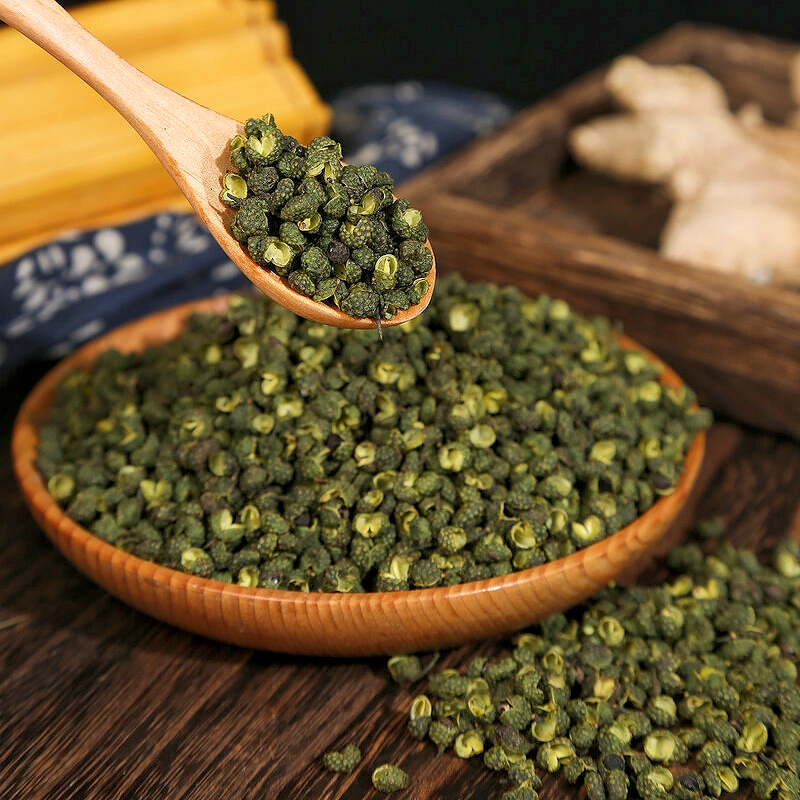
Jinyang green pepper:
The main characteristics of Jinyang green pepper are yellow-green color, rounded particles, full oil glands, and good quality uniformity, but the opening is generally low;
Hempin is about: 25-30 (mg/g), which is preferred by enterprises that extract pepper oleoresin
It is also an indispensable condiment for mustard, hot pot, Sichuan cuisine, and pepper seasoning oil.
Yunnan green pepper:
Yunnan green pepper: the color is light green, the seeds are full, the skin is thick and the flesh is abundant, its hemp taste and fragrance are more pure, the hemp degree is higher, the mouth is hemp fragrant, compared with Jinyang green peppercorns, slightly secondary, but the opening is better, the quantity is huge, it is the mainstay of green peppercorns on the market at present;
Hempin is about: 23-28 (mg/g), which is also the preferred raw material for extracting Zanthoxylum pepper oleoresin;
It is often used in some hot pot braised vegetables, boiled fish and other series, and also adds color and hemp to food condiments.
Remark:
Zhaotong pepper is produced in Zhaotong Yanshan, the hometown of Longyun. Raw green and red, spicy, numb, warm and fragrant. In the "Compendium of Materia Medica", there is a famous Qin pepper, which has the effects of dilating blood vessels, strengthening the spleen and appetizing, and anti-cancer.
The planting area of green pepper in Ludian County, Zhaotong, Yunnan Province is 235,000 mu, and the output is 8,800 tons
Among them, the planting area of pepper in Longtoushan Town is 68,000 mu, with an annual output value of 300 million yuan.
Zhaotong is one of the origins of Zanthoxylum, in the regional Niulan River, Guanhe River and the east bank of the Jinsha River in the mountains, there is a kind of wild pepper called "dog shit pepper" generally grows, which is the original form of Zanthoxylum, is the ancestor of modern domestic pepper.
Yanshan pepper is a key production area. The pepper produced here has a large quantity, good quality, strong fragrance, numb flavor, and has high medicinal and edible value.
Its variety of pepper has large particles and bright red color, and is also known as "big red robe". The pepper particles are small and red, and they are called "little red robes". The green pepper grains are uniform, and because the color is gray-green, hence the name.
Although the green pepper is not as large as the big pepper in terms of color and luster, the small red robe is fresh and moist, but the quality is particularly good, better than the red pepper.
Yue Shengzhuang:
The color of Jiangjin green pepper is dark green to dark green, the particles are uniform and full, and the opening is good, which is favored because of its early harvest season and moderate price;
Hempin is about: 20-25 (mg/g), but due to the bitter aftertaste of Jiangjin green pepper, it is generally used for market circulation or milling;
At present, the preserved peppercorns on the market are basically made of Jiangjin peppercorns, and almost all of the fresh peppers used in hot pot restaurants are Jiangjin green peppercorns.
Wisteria:
Rattan pepper: the fruit is full, the particles are small, green, with a strong hemp fragrance, sweet aftertaste, and light bitterness.
Hempin approximately: 16-23 (mg/g), due to the low content of rattan pepper hemp and essential oil, due to the high cost of supercritical extraction, the cold pressing and extraction process is now used to extract more;
It is suitable for rattan pepper oil, braised vegetables, hot pot dipping sauce, etc.
References
Zanthoxylum bungeanum. Chinese Natural History Museum. Cited on 2016-09-28
Flora of China Editorial Committee. Flora of China, Vol. 43. Science Press. 1997:44
Yi Mingqin. Zanthoxylum bungeanum cultivation technology. Rural Science and Technology. 2019, No. 2:77-78
Zhang Zhe, Jian Zhen. Zanthoxylum bungeanum cultivation technology. Agricultural Knowledge. 2018, No. 42:41-43
State Administration of Traditional Chinese Medicine "Chinese Materia Medica" Editorial Committee; Chinese Materia Medica 1; Shanghai Science and Technology Press; 1999;977-979
Zheng Yuguang, Jing Yongshuai, ed. Taihang Mountain Medicinal Plant Atlas Series Cangyan Mountain Medicinal Plant Atlas. 2021
Zhang Zhengxiong, Dong Yusheng, Chongqing Xiaomian Complete Dictionary. 2021
Wang Wenxue, Yue Wangzi, ed. Panshan Village Chronicle. 2009
Bi Jun, Zhao Jingxian, Wang Chunrong, Zhao Yufen. Overview of pepper research at home and abroad. Economic Forest Research, 2002, (Issue 1).
Chen Bingjin et al. Seasoning cultivation and processing technology. 1997
What is manna food?
Manna foods wholesale spices worldwide. Manna Foods is the most professional exporter of Sichuan peppercorns in China. Main products are Whole sichuan peppercorn,green sichuan pepper,Red Sichuan peppercorns,green Szechuan pepper powder; Red Szechuan pepper powder, Crushed Chinese prickly ash,Frozen Sichuan pepper and so on.
The biggest challenge in exporting Chinese peppercorns is the control of the minimum pesticide residue standards. Many foreign trade companies may meet the standards for one shipment. However, it is very difficult to provide a long-term and stable supply of Chinese peppercorns that meet the minimum pesticide residue standards. This is the main advantage of Manna Foods!
Contact Us
008615253285515
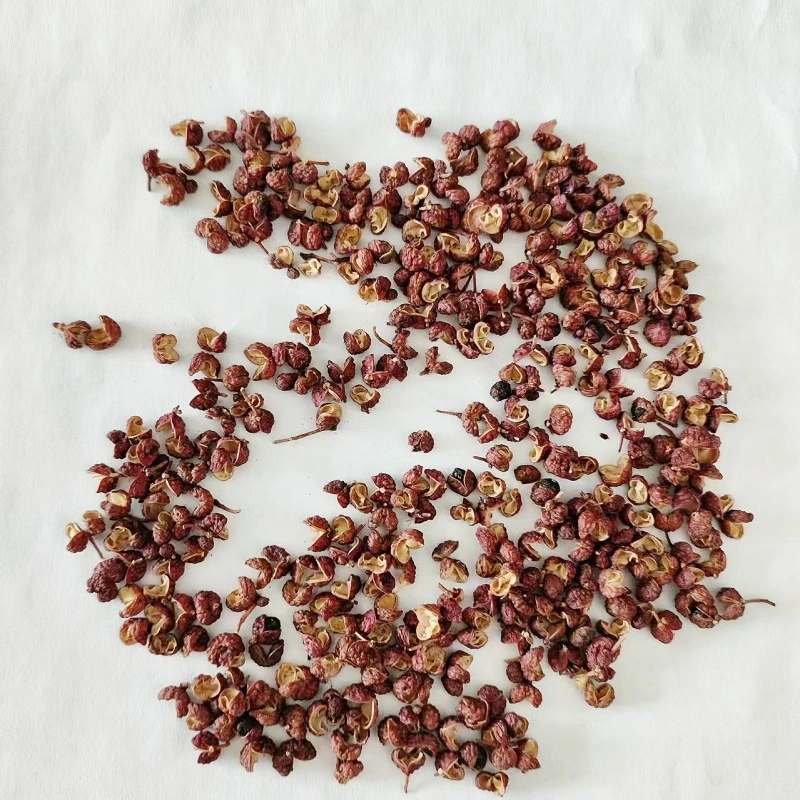

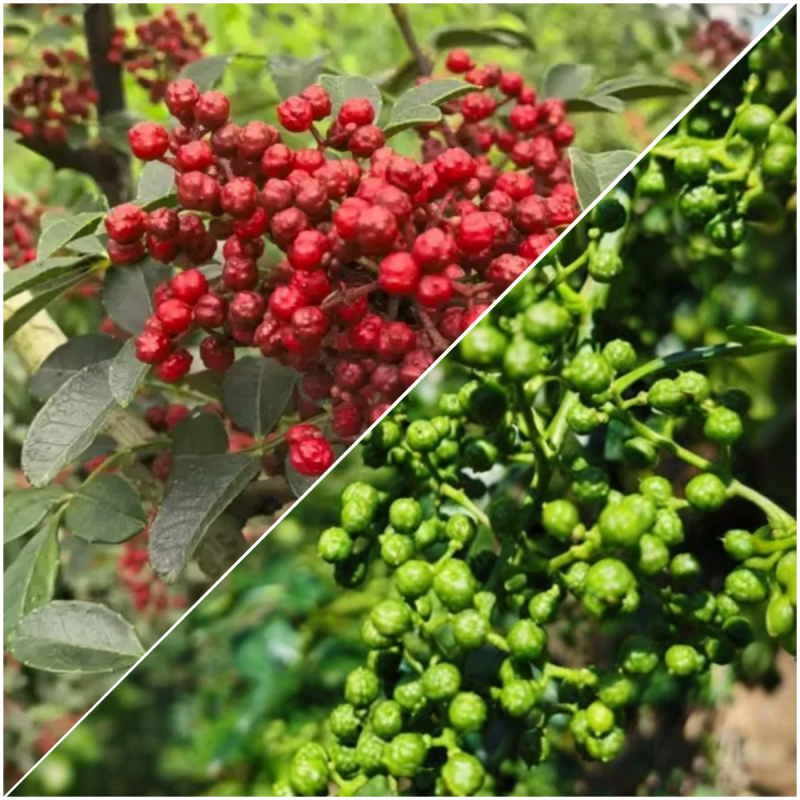
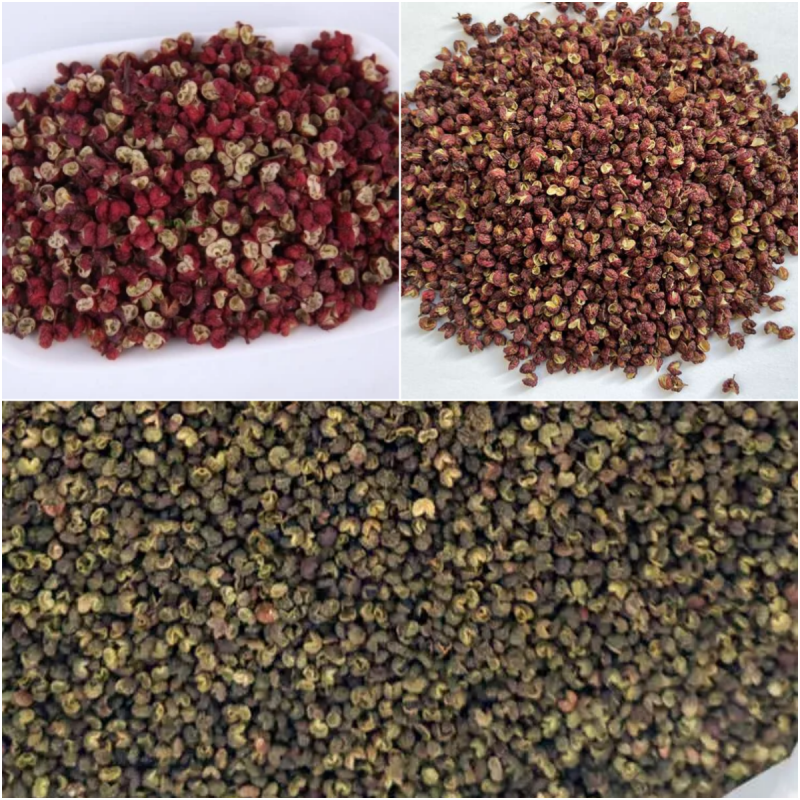
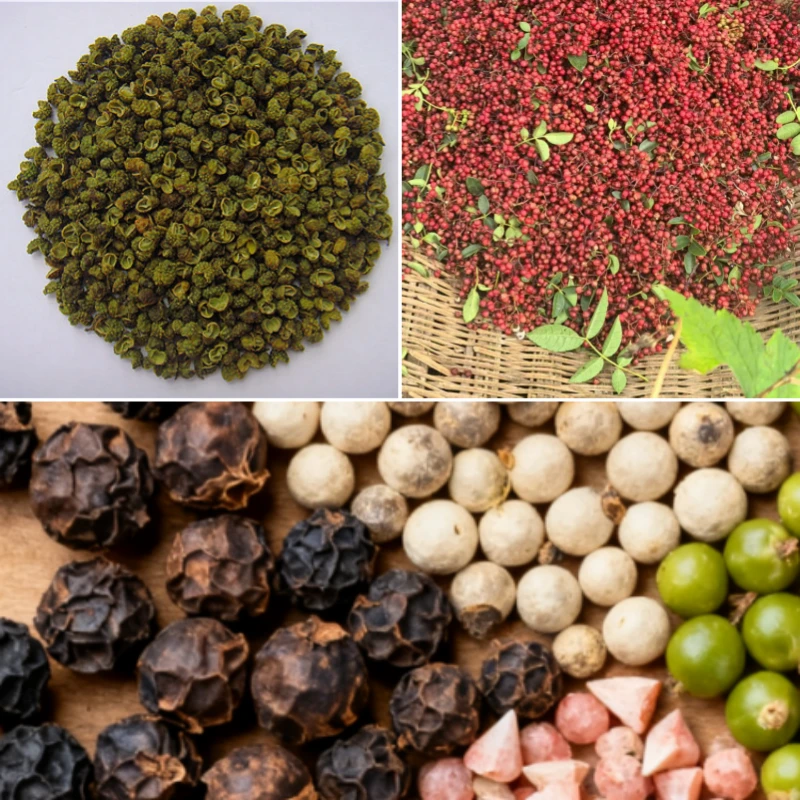
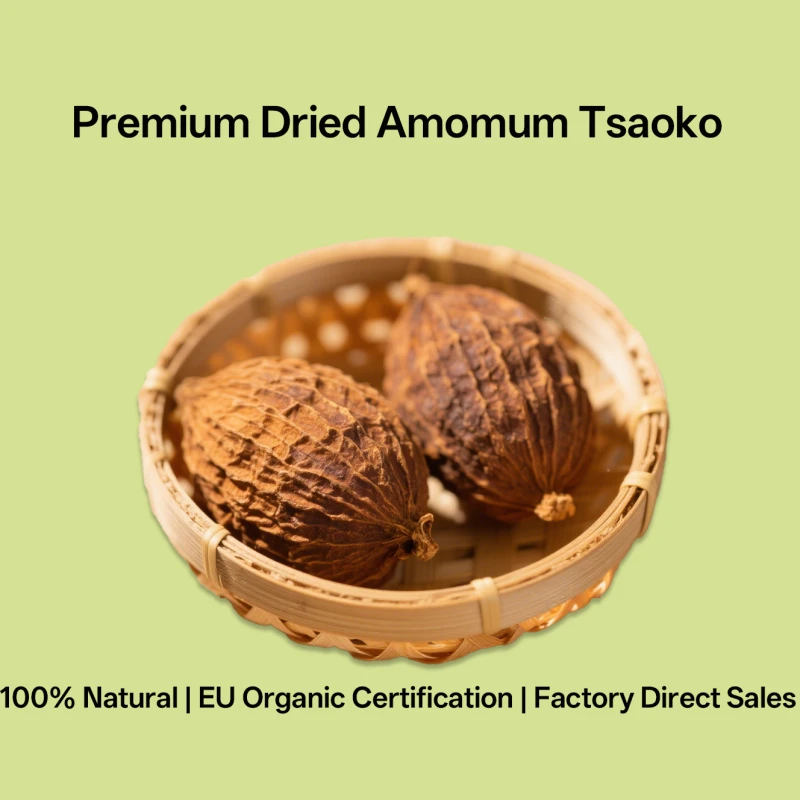
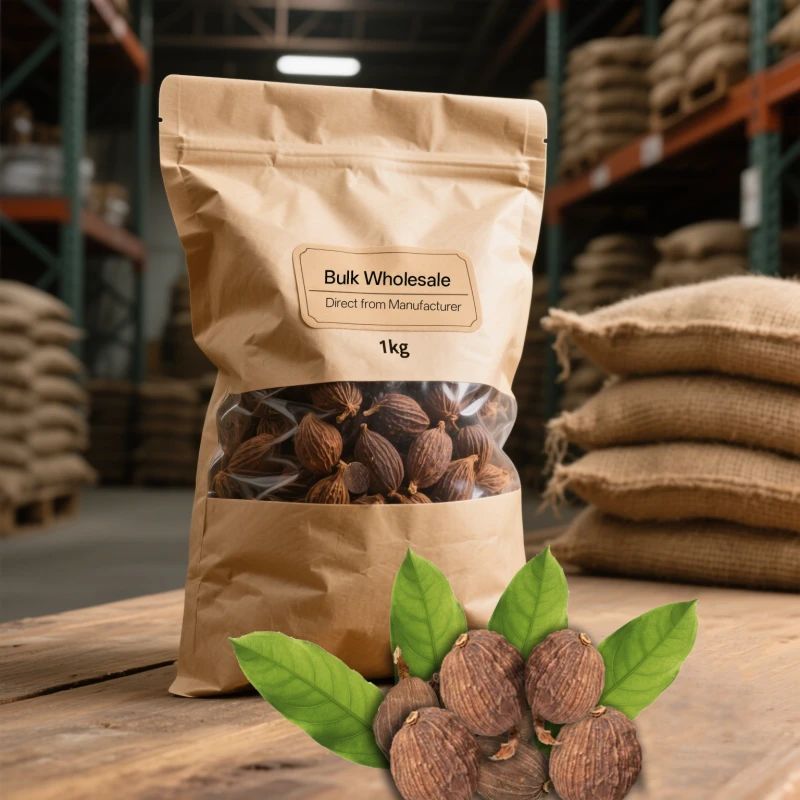
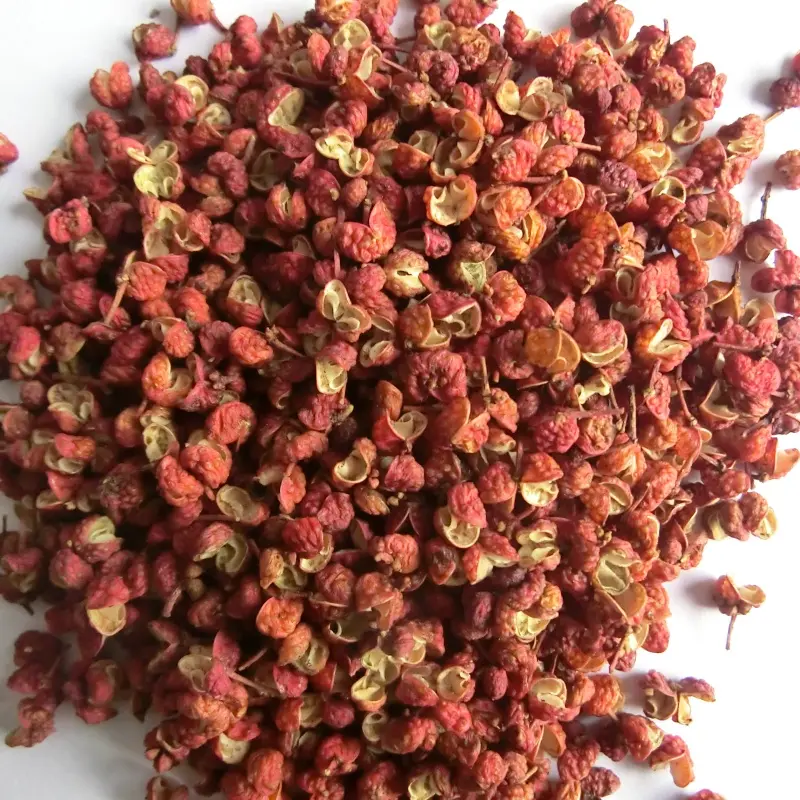
811.webp)
